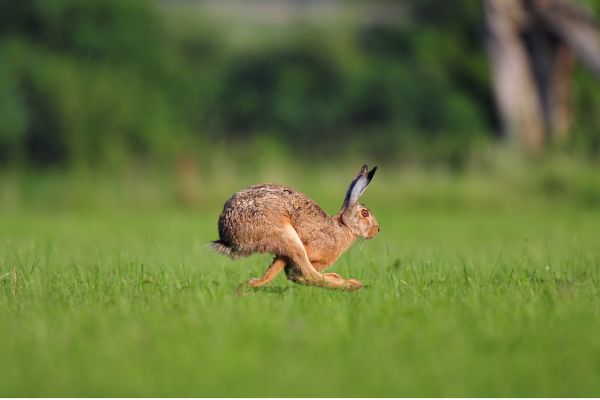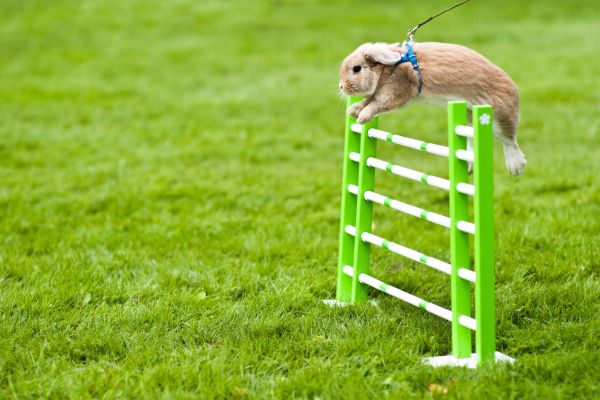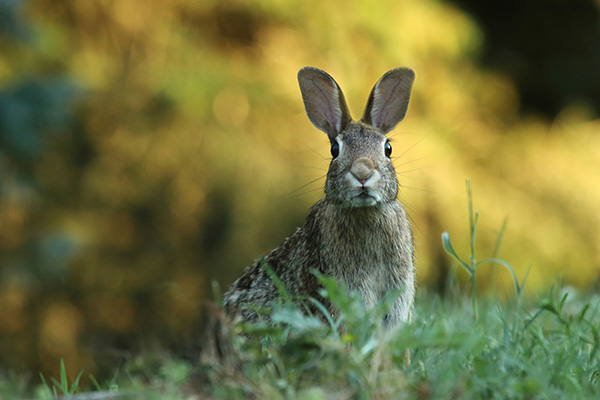Rabbits are renowned for their impressive jumping abilities in the animal kingdom, a skill that serves them well both in the wild and as domestic pets. With the ability to leap as high as 2 to 3 feet and some exceptional rabbits reaching up to 4 feet, these agile creatures showcase remarkable strength and agility. Understanding rabbits' jumping capacity is crucial for pet owners and rabbit enthusiasts alike, as it helps ensure their safety and well-being.
Whether in rabbit jumping competitions or simply navigating their environment, rabbits' jumping prowess is a testament to their natural athleticism. In this article, we will share how high rabbits can jump and dive into the factors influencing rabbit jumping heights, safety considerations, and training tips to enhance their abilities.
How high can rabbits jump
The average jumping height for domestic rabbits typically ranges between 2 to 3 feet. The House Rabbit Society reports that most rabbits can leap heights of up to 36 inches. This impressive agility allows them to easily navigate their environment, whether hopping over obstacles or exploring new territories. However, some exceptional rabbits can leap even higher, reaching up to 4 feet under certain conditions.
The highest rabbit jump is 107 cm (42.1 in). This impressive feat was achieved in March 2023 by Holloway GtCh Tennessine, a rabbit owned by Marie Kozubková from the Czech Republic. This remarkable achievement highlights rabbits' extraordinary jumping capabilities, showcasing their agility and strength.
Factors That Influence Jumping Ability
Breed

Different rabbit breeds demonstrate different levels of agility and jumping prowess. Medium-sized breeds, such as the Belgian Hare and the English Spot, are known for their superior jumping skills. These breeds have a balanced proportion of muscle mass to body weight, which provides the optimal combination for higher jumps. In contrast, dwarf breeds like the Netherland Dwarf, while agile, may not achieve the same height due to their smaller stature.
Size
The size of the rabbit significantly impacts its jumping capability. Medium-sized rabbits, weighing between 4 to 8 pounds, often have the best balance of muscle power and body weight. Very small breeds might lack the necessary muscle mass, while large breeds, such as the Flemish Giant, might be hindered by their weight despite strong muscles.
Age
Age significantly influences a rabbit's physical capabilities. Young rabbits, especially those under the age of five, typically exhibit higher energy levels and greater muscle strength, which contribute to their jumping prowess. As rabbits age, their muscle mass and joint flexibility can decrease, reducing their ability to jump high.
Health Condition
A rabbit's overall health directly affects its jumping ability. Healthy rabbits with a proper diet and regular exercise are more likely to maintain strong muscles and flexible joints, which are essential for high jumps. Health issues such as obesity can significantly impair a rabbit’s agility. Overweight rabbits bear additional weight, which can impede their ability to lift off the ground. Joint problems, like arthritis, can also hinder a rabbit’s jumping ability due to pain and reduced mobility.
Genetics
Genetics is crucial in determining a rabbit’s physical abilities, such as its jumping prowess. Rabbits bred from lines known for athleticism and agility are likely to inherit these traits. For instance, rabbits used in competitive jumping or agility sports often come from genetic lines that emphasize these abilities. Understanding a rabbit's genetic background can give insights into its potential jumping skills.
Training

Regular training can significantly improve a rabbit's jumping ability. Setting up obstacle courses with varying heights can challenge and enhance a rabbit’s agility and strength. Consistent training sessions that include positive reinforcement, such as treats and praise, are essential to motivate rabbits and ensure enjoyable training experiences. According to Hoppy Buddies, using positive reinforcement and gradually increasing the difficulty of the jumps can help build the rabbit’s confidence and ability.
Conditioning
Conditioning is about keeping the rabbit in peak physical condition through a balanced diet and ample exercise. A well-conditioned rabbit will have stronger muscles and better endurance, contributing to its jumping prowess. Regular exercise prevents obesity and maintains muscle tone, both crucial for high jumps.
Environment
The environment in which a rabbit resides can significantly impact its physical capabilities. Rabbits that have access to spacious areas where they can hop, explore, and play are more likely to develop strong muscles and agility. In contrast, rabbits kept in confined spaces may become sedentary, leading to weaker muscles and reduced jumping ability. Offering an enriched environment with ample opportunities for physical activity can enhance a rabbit's innate abilities. According to The Spruce Pets, creating a safe and stimulating environment is essential for a rabbit’s physical and mental well-being.
Motivation
Motivation is a key factor in how high a rabbit will jump. Rabbits are more likely to exert themselves and jump higher when they have a reason. This motivation can come from various sources, such as the presence of food and toys or even the desire to explore new territories. Positive reinforcement, such as offering treats or praise when the rabbit successfully completes a jump, can encourage them to continue practicing and improving their jumping skills.
Jumping in the Wild vs. Domestic Rabbits
Wild Rabbits

Wild rabbits have evolved as prey animals to develop impressive jumping abilities primarily for survival. These rabbits must navigate complex and sometimes hostile environments, requiring them to leap over obstacles and quickly escape predators. The average wild rabbit can jump distances of up to 10-15 feet in a single leap and heights of up to 4 feet. This ability is crucial for dodging predators such as foxes, hawks, and other carnivorous animals that constantly threaten their survival.
Wild rabbits' powerful hind legs are specially adapted for these high and long jumps, providing the necessary strength and speed. Their agility and quick reflexes are honed through natural selection, as those who can jump higher and farther are more likely to survive and reproduce. The terrain they inhabit often necessitates these jumps, whether to navigate through dense vegetation or quickly reach their burrows' safety.
Domestic Rabbits
In contrast, domestic rabbits do not encounter the same survival pressures as their wild counterparts. While they retain the physical capability to jump, the necessity to do so is greatly diminished in a controlled environment. Domestic rabbits typically jump between 2 to 3 feet high, with exceptional other rabbits reaching up to 4 feet. These jumps are often seen during play or when navigating their living spaces.
The environment of domestic rabbits is generally safe and lacks predators, reducing the need for extreme jumping capabilities. Domestic rabbits may be provided with ample food, shelter, and care, which removes the evolutionary pressures that shape the behaviors and physical attributes seen in wild rabbits. Additionally, selective breeding for traits such as temperament and appearance rather than survival skills can influence their jumping abilities.
Despite the reduced need for survival-driven jumps, domestic rabbits can still benefit from environments that encourage their natural behaviors, including jumping. Enrichment activities, such as obstacle courses and toys, can help domestic rabbits exercise their muscles and maintain their agility. Owners can set up safe spaces that mimic wild rabbits' challenges, promoting physical health and mental stimulation.
Safety Considerations For Pet Rabbit
Appropriate Fencing
Enclosure Height: Domestic rabbits can jump surprisingly high, often up to 3 feet, and some exceptional ones can reach up to 4 feet. Therefore, it's essential to have enclosures and playpens with walls at least 3-4 feet high to prevent escape. Ensuring the height of the rabbit fence is adequate can help keep your rabbit safe within its designated play area.
Secure Gates: All gates and doors in the enclosure should be securely closed and locked. Rabbits are curious and can push through unsecured openings, leading to potential escapes and dangers outside their safe zones.
Non-Slip Surfaces: Providing non-slip surfaces within the enclosure is vital. Rabbits have delicate limbs that can easily slip and twist on smooth or slippery surfaces, leading to injuries. Using rubber mats, carpets, or non-slip tiles can help ensure a stable footing for your rabbit.
Avoid High Altitudes
Limit Access to Heights: It’s crucial to avoid placing rabbits on high surfaces such as tables, counters, or elevated platforms. A fall from such heights can result in severe injuries, including broken bones or internal damage. Rabbits do not have the reflexes to land safely from significant heights like cats do.
Safe Platforms: If your rabbit’s habitat includes platforms or shelves, ensure they are close to the ground. Equip these platforms with ramps or steps to help your rabbit climb up and down safely without the risk of falling.
Bunny-Proofing Areas
Cover Electrical Cords: Rabbits love to chew, and electrical cords are a common target. To prevent the risk of electrocution, use cord protectors or hide electrical cords out of reach. Plastic tubing or spiral wrap can be effective solutions for covering cords.
Secure Furniture: Ensure that heavy furniture and appliances are secure and cannot be tipped over by a curious rabbit. Rabbits can crawl under or behind furniture, potentially getting stuck or injured.
Block Small Spaces: Cover or block small spaces where your rabbit could get trapped. Using baby gates or barriers can restrict access to dangerous areas and ensure your rabbit stays in a safe environment.
Provide Safe Jumping Areas
Soft Landing Zones: Create areas with soft materials like rugs or mats where your rabbit can jump and land safely. This helps cushion their falls and prevents injuries. Avoid hard surfaces that can cause harm if your rabbit lands awkwardly.
Obstacle Courses: Setting up safe and controlled obstacle courses with varying heights can encourage exercise and agility training. Ensure the obstacles are stable and have soft edges to prevent injury.
